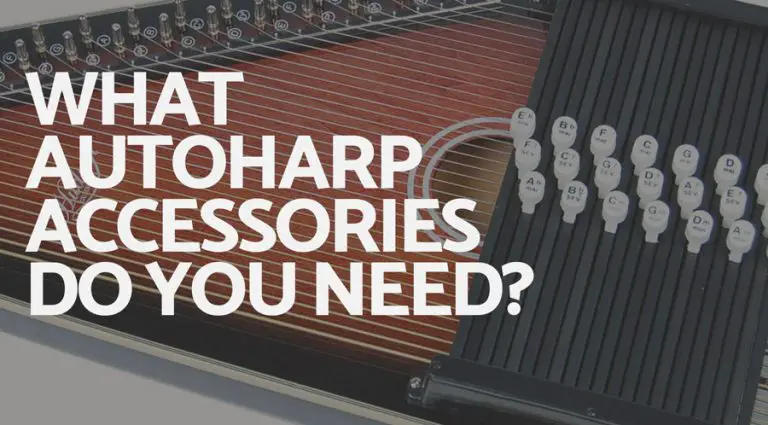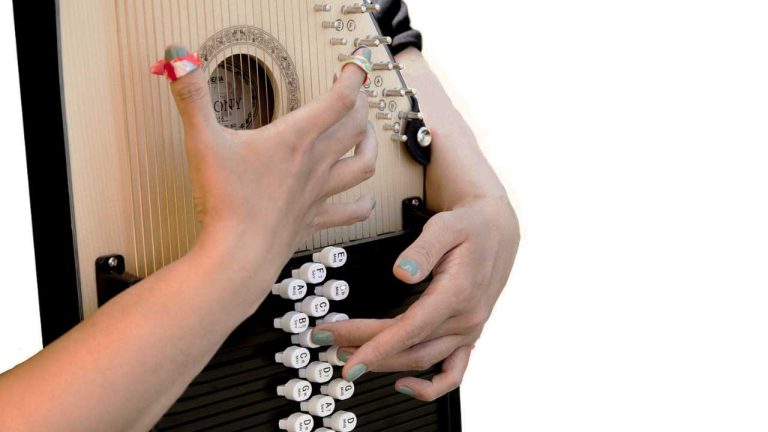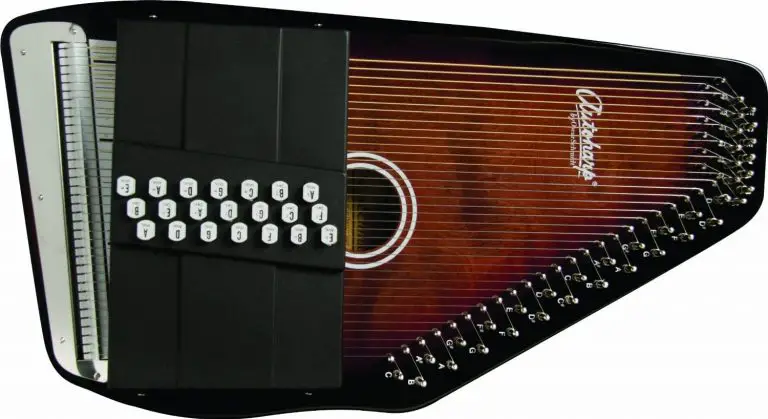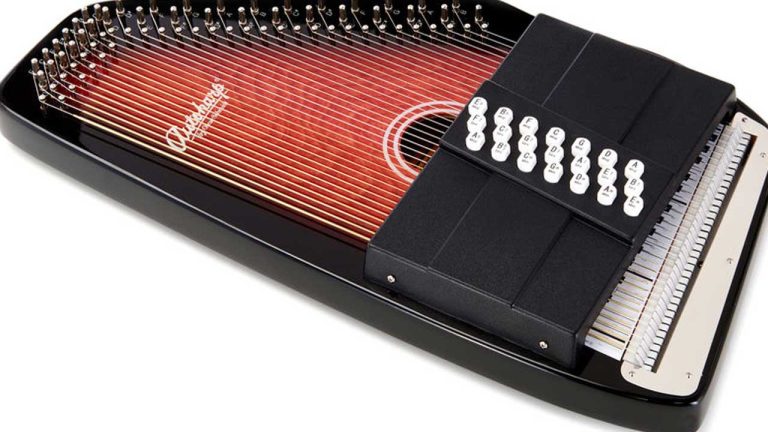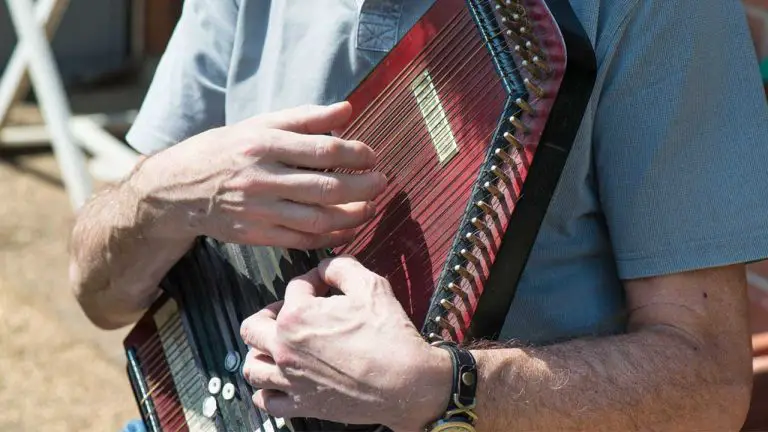Should I Buy a New or a Secondhand Autoharp? Deciding on the Best Option for You
Folkstrings.com is reader-supported. When you buy through links on our site, we may earn a small commission.
Deciding whether to buy a new or secondhand autoharp can be challenging. As an enthusiast looking to venture into playing this multi-stringed instrument, I realize that new autoharps come with the assurance of untouched quality and potentially the latest features. On the other hand, a used autoharp often presents a more affordable option which can be appealing, especially if my budget is limited.
My consideration extends beyond the initial cost to factors such as the condition of the instrument, its sound quality, and any included warranties or return policies.
Although the financial aspect is a significant factor in my decision, technical considerations are equally important. I consider if I require an instrument that is ready to play right out of the box, which is typically the case with a new autoharp, or if I’m willing to possibly incur additional costs for repairs and maintenance with a secondhand option.
My choice also depends on my level of experience and commitment to learning the instrument. A beginner might lean towards a less expensive, secondhand option, while a more experienced player might invest in a new, high-quality autoharp.
Key Points
- Buying a new autoharp offers quality and the latest features while a used one is more budget-friendly.
- The condition and potential repair costs of a secondhand autoharp are crucial technical considerations.
- My experience level and commitment shape my decision between purchasing new or used.
Table of Contents
Considering New vs. Used Autoharps

When I’m making the decision to buy an autoharp, I consider the instrument’s condition, the advantages of purchasing it new or used, and the source of the autoharp.
Understanding Autoharp Conditions
In my experience, examining an autoharp’s condition is vital. I check for any warping in the wood, ensure the strings are intact, and look for signs of well-maintained gloss or black satin finishes. If I’m eyeing a secondhand autoharp, I am particularly cautious about any cracks that could impact its sound quality.
Pros and Cons of New Autoharps
Pros:
- I get a pristine instrument with no wear.
- New autoharps often come with a warranty.
Cons:
- New autoharps are more of an investment.
- There might be limited models available, like the Oscar Schmidt or Chromaharp.
Pros and Cons of Secondhand Autoharps
Pros:
- I can find unique vintage pieces from the 70s on eBay or Amazon.com that have their own musical character.
- It’s typically less expensive than buying new.
Cons:
- There is a risk of inheriting hidden damage.
- Used musical instruments may not come with a warranty, requiring extra cost if repairs are needed in the future.
Financial Aspects of Acquiring an Autoharp
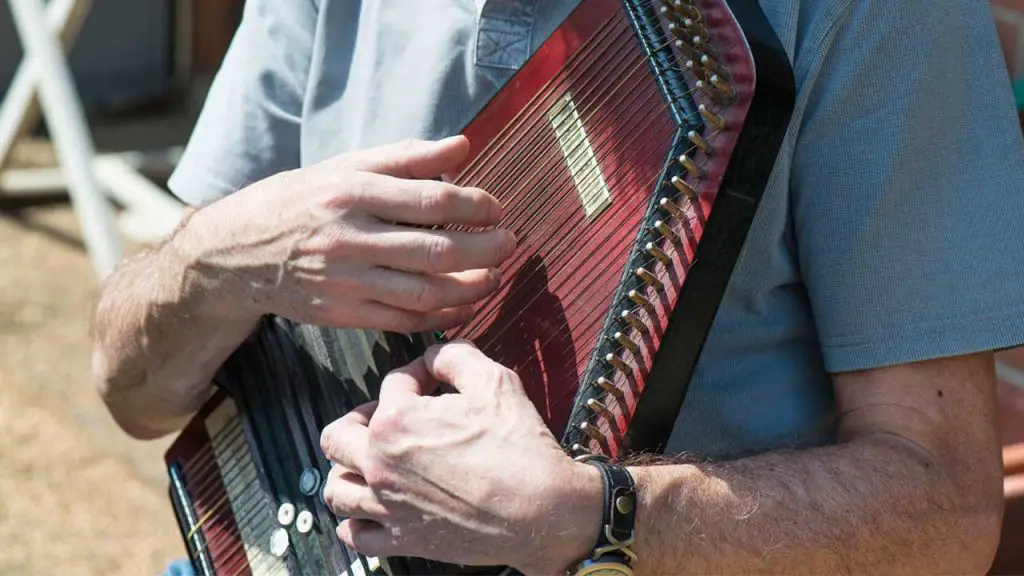
When I decide to buy an autoharp, I consider two main financial angles: the initial cost and the long-term value. Let’s explore these in detail.
Evaluating the Costs
Firstly, I look at the immediate costs of purchasing an autoharp. New autoharps can range from $100 to well over $500 depending on the make, model, and features. However, secondhand options oftentimes present a lower upfront cost. I also consider additional expenses such as:
- Tuning tools
- Replacement strings
- Cases for transport
It’s not just the sticker price I think about; I take into account the total cost of ownership.
Autoharps as an Investment
Investing in an autoharp may pay off in the long run, especially if I’m buying a well-made instrument that retains its value. A new autoharp could see a slight decline in resale value once it’s been played, but if I keep it in good condition, it could still be a worthwhile asset. Conversely, purchasing a secondhand autoharp in great condition might not depreciate much further, making it a smart buy financially. Here’s how I break it down:
| Autoharp Condition | Financial Consideration |
|---|---|
| New | Higher initial cost, potential for moderate depreciation, but long-term value retained with proper care. |
| Secondhand | Lower initial cost, less depreciation, potential for increased value if it’s a collectible or well maintained. |
I remember that my personal satisfaction with the instrument and the joy I get from playing also add value beyond the financial expense.
Technical Considerations for Autoharps
In considering whether to buy a new or secondhand autoharp, it’s crucial to understand the technical aspects that impact playability and durability. From different types of autoharps to their maintenance needs and the effect of materials on sound quality, I’ll guide you through the key information.
Different Types of Autoharps
Autoharps come in several varieties, distinguished primarily by the number of chords they support. The two most common types are the 15-chord and the 21-chord autoharps.
A 15-chord autoharp is typically more suited for beginners, while a 21-chord autoharp like the OS21C or Chromaharp 21 offer a broader range, allowing for more complex music. Diatonic autoharps, such as the OS73C, are tuned to a specific key, which limits their versatility but enhances their rich, full sound in that key. Chromatic autoharps can play in multiple keys, making them more flexible.
Additionally, some autoharps like the OS45CE feature a fine-tuning system that allows for more precise tuning stability.
Tuning and Maintenance
The integrity of the tuning system is essential. You will find tuning pins and fine-tuning systems that facilitate precise adjustments. Especially with a brand new autoharp, like the OS11021AE, ensure that the tuning system operates smoothly.
Regular tuning is also important due to the potential for temperature and humidity changes to affect the strings. For maintenance, a sturdy autoharp case or gig bag offers protection during storage and transport, helping maintain your instrument’s condition.
Sound Quality and Materials
The materials used for the autoharp significantly influence its sound quality. The soundboard, commonly made of spruce or mahogany, shapes the instrument’s tone.
The OS11021AE, for example, is noted for its fine spruce top that resonates well. The maple wood pin block in an autoharp ensures tuning stability. A plastic autoharp or one with a plastic soundboard will generally not have the same sound quality as a solid wood instrument.
If you’re examining a used autoharp, check for signs of wear on the chord bars, springs, and tuning pins, as these can also affect sound. Always remember, the best autoharp for you is one that matches your tonal preference and comfortable playing style.
Making the Decision
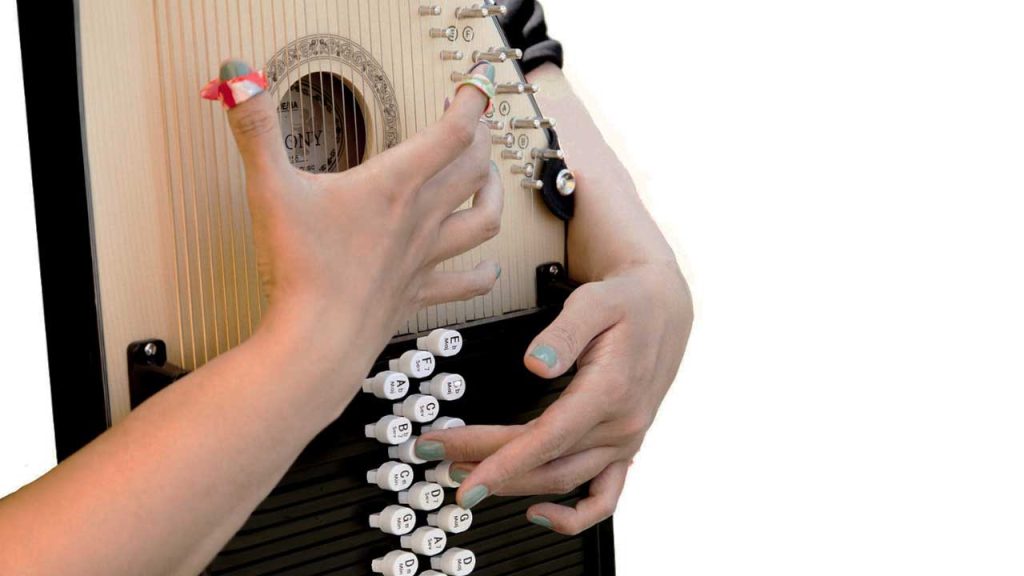
When deciding between a new or secondhand autoharp, consider not just the cost but also the condition, sound quality, and the presence of any unique features or modifications. My focus will be on where you can find autoharps and some pivotal tips I’ve learned that you should consider before finalizing your purchase.
Where to Buy Autoharps
I’ve discovered that new autoharps are typically available at music stores or online through reputable dealers. Keep in mind that models like the 21 chord, equipped with fine tuners and lock bars, are common in newer editions. They offer chromatic playability, which caters well to playing in both major and minor keys.
For those who love unique instruments, specialty shops or online marketplaces might have listings for vintage or custom-made autoharps—like the rare Model A or those made from cherry wood. It’s important to me that I can see or hear the instrument, so for secondhand purchases, I try to find local sellers or consider online platforms that provide sufficient visuals and descriptions.
Used autoharps often pop up on auction sites or in places where bidding is the norm; I make sure to check the credibility of the seller and the condition of the instrument carefully. If you’re like me, wanting something with history, a secondhand chorded zither or variants like the psaltery might be enticing, but always inquire about the accessories like the tuning hammer, which are vital for maintenance.
Final Tips Before Purchase
Before I commit to buying an autoharp, I use this checklist to ensure I make an informed decision:
- Condition: A thorough check for any signs of damage or excessive wear is crucial.
- Accessories: Confirm that essential items like a tuning hammer are included or easy to source.
- Tuning: I play every string to ensure the tuning is stable and the sound is crisp.
- Sound: The quality of tone, resonance, and volume should meet my expectations.
- Features: For contemporary music, I look for an autoharp with at least 21 chord bars or any additional unique features that appeal to me.
- Research: I always read reviews or ask fellow autoharp players for their opinions on the specific model or brand.
Frequently Asked Questions
When deciding between a new or secondhand autoharp, it’s crucial to weigh several factors to make an informed decision.
What should I consider when choosing between a new or used autoharp?
In my decision between a new or used autoharp, I consider the instrument’s condition, price, and whether I want the latest model or am happy with a potentially older design that a used one might offer.
How does the age of an autoharp affect its playability and sound?
The age can be significant. A well-maintained older autoharp might have a mature, settled sound, while a new one might have a brighter tone and tighter strings. A new autoharp might also need a break-in period.
What are the pros and cons of buying a secondhand autoharp compared to a new one?
Buying a secondhand autoharp can be cost-effective and environmentally friendly. On the downside, it may come with no warranty, potential hidden damage, or wear that could affect performance.
What advice do experts give about purchasing pre-owned musical instruments?
Experts often suggest checking the instrument’s condition thoroughly. They also recommend playing it or having it checked by a professional before purchase and ensuring it has been well-cared-for.
How can I ensure I’m getting a good deal on a used autoharp?
To ensure a good deal, I research the market price, examine the autoharp’s condition in person, and verify any included accessories or documents that validate its maintenance history.
What are the signs of wear to look for when evaluating a secondhand autoharp?
When evaluating a used autoharp, I look for signs of wear such as cracked wood. I also check for rusted strings, loose tuning pins, and worn felts on the chord bars. These signs may indicate that repairs are needed.
Author Profile
-
Daniel Johnstone is an English writer with a love for stringed instruments from around the world.
He shares his love for these instruments through his writing for folkstrings.com, a website dedicated to all things related to folk string music.
Daniel's passion for music started at a young age, and he has since become an accomplished musician, playing guitar, cavaco, and recently, the harp.
His dedication to learning and sharing his knowledge of stringed instruments is evident in his insightful and engaging blog posts. Whether you're a seasoned musician or a beginner, Daniel's writing is sure to inspire and entertain you.
When he's not playing music or writing, you can find Daniel exploring new instruments and seeking out new sounds to share with his readers.
Latest entries
 AutoharpApril 4, 2024What Is the Autoharp Made Of: Exploring Its Materials and Craftsmanship
AutoharpApril 4, 2024What Is the Autoharp Made Of: Exploring Its Materials and Craftsmanship AutoharpApril 4, 2024Is Autoharp Easy to Play? Unveiling the Truth for Beginners
AutoharpApril 4, 2024Is Autoharp Easy to Play? Unveiling the Truth for Beginners AutoharpApril 4, 2024What Is an Autoharp Worth? Your Guide to Pricing and Value
AutoharpApril 4, 2024What Is an Autoharp Worth? Your Guide to Pricing and Value AutoharpApril 4, 2024Are Autoharp and Zither the Same Thing? Unraveling String Instrument Myths
AutoharpApril 4, 2024Are Autoharp and Zither the Same Thing? Unraveling String Instrument Myths
Affiliates:
This post may contain affiliate links that at no additional cost to you, the site may earn a small commission. We only recommend products we would use ourselves and all opinions expressed on this site are our own.
Accuracy Advice:
While we strive to provide up-to-date and accurate information, the content in this article may not reflect the most current research or medical guidelines. We encourage readers to do further research and consult with professionals for more personalized advice.
Our Recommendations:
The products and services mentioned in any of our articles are recommended based on our independent research and personal experience. We are not sponsored by any company. We aim to suggest products and services we believe are of high quality and could be beneficial to our readers.

